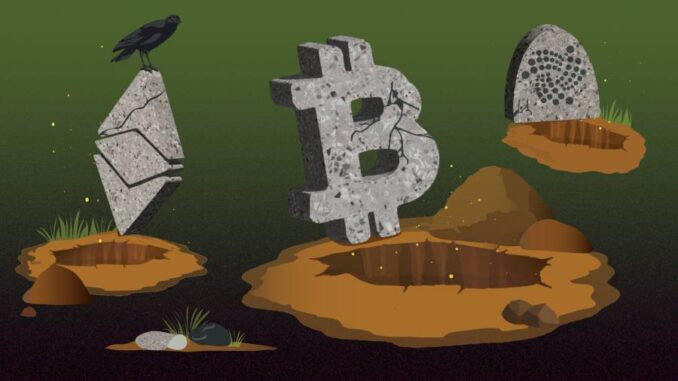
Earlier this year, an Irish company that organises an annual tech conference in Toronto called Collision decided to celebrate cryptocurrency’s “day in the sun”, as the blurb said, by inviting its luminaries to speak.
Oops. By the time Collision finally happened this week, 35,000 attendees turned up, but eight of the dozen-odd top crypto speakers suddenly dropped out, citing “family” and “health” reasons.
And instead of basking in the sun, crypto enthusiasts were confronting winter. The sector’s market capitalisation has shrunk by $2tn, or 70 per cent, since last November; the bitcoin price has tumbled below $20,000, the terra and luna stable coins have imploded; crypto lenders such as Babel and Celsius have halted withdrawals; and hedge funds like Three Arrows Capital face margin calls.
Moreover, the carnage would be even worse were it not for the fact that Sam Bankman-Fried, the 30-year-old billionaire founder of the FTX crypto platform, is bailing out crypto lenders such as Voyager and BlockFi with big loans. This echoes the moves that John Pierpont Morgan made during the 1907 American banking crisis to rescue other lenders, in the absence of any central banking backstop.
All this is distinctly embarrassing for crypto evangelists. And it has inevitably sparked schadenfreude from crypto-critics such as Bill Gates and Warren Buffett. It has also left some regulators voicing doubts about whether private cryptocurrencies really have any social utility — future.
This week, officials at the Monetary Authority of Singapore said they planned to be “unrelentingly hard” on crypto — and thought that private digital money could soon be displaced if central banks issued their own digital tokens. This is significant, particularly given that the MAS was formerly quite warmly disposed towards crypto. The establishment is fighting back.
But I would not be ready to bet that private digital money will actually die — mutation seems more likely. After all, the crypto world has already endured some big busts, yet — like the proverbial hydra — it has always responded to decapitation by growing new heads. And the sector still boasts a big pool of players who are not only convinced of the revolutionary potential of their distributed ledger (or “Web3”) technology, but equally importantly believe in the idea of creative destruction.
“Over the next few weeks there will be more casualties, but this natural churn is healthy for the industry since it is removing the excess,” Brian Shroder, US head of the crypto exchange Binance, said at Collision. “Out of the dotcom bubble (and crash) Amazon emerged, and we want to be an Amazon.” Or, as Edith Yeung of the crypto fund Race Capital echoed: “This is the third time I have seen this [type of crypto crash]. It is a good thing for the industry.”
Maybe this is just desperate spin. But if you look closely, you can already see jostling around creative destruction. The companies imploding are those that feature one or all of the following traits: high leverage, opposition to regulation, excessively complex innovations and heavy spending on expansion. Others are faring better.
Take Binance itself. One reason why Shroder felt confident enough to appear on stage in Toronto, unlike other speakers, is that Binance’s business does not rely on margin trading or crypto lending. That makes it less vulnerable than some rivals. (Although it does face US regulatory investigations over its past promotion of the now-defunct Terra coin.)
Another important factor is that Binance recently raised $200mn in fresh capital, which it is using to diversify into new niches. Thus it is now hiring more staff, Shroder says, even as rivals such as Coinbase slash workers.
Or consider Circle, the company that runs the stablecoin USDC. In recent years USDC has attracted far less attention — and inflows — than its rival Tether, partly because the latter’s creators have taken a defiantly anti-establishment stance that was popular among libertarians, while horrifying regulators. (Last year, New York regulators settled with the company after accusing it of providing misleading information in its accounts.)
Circle, by contrast, has tried to keep the regulators sweet by producing audited accounts, talking about its desire to get a bank licence and courting mainstream financial players.
But while this used to make USDC less attractive for crypto players, its market capitalisation has grown from $48bn to $56bn in recent weeks due to strong inflows. Tether, in contrast, has seen outflows that have cut its market cap from $83bn to $67bn, and if this trend continues it could be eclipsed by USDC. “We are seeing an overall flight to safety and quality,” asserts Jeremy Allaire, Circle founder.
By pointing out these nuances, I am not trying to pick future winners. As Gavin Wood, the co-founder of Ethereum, noted in Toronto, “we are still in relatively early days of the development of this [Web3] technology”.
But the key point is this: just as no one in 2001 expected that Amazon would be a global giant two decades later, or that Silicon Valley’s power would keep expanding, so the crypto world in 2042 could be radically different from what we see now. Therein lies the future promise of Web3 — and the current peril.
gillian.tett@ft.com






Be the first to comment